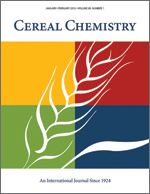
Cereal Chem 50:133 - 139. | VIEW
ARTICLE
Preparation and Chemical Composition of Sweet Potato Flour.
M. G. E. Hamed, M. F. Hussein, F. Y. Refai, and S. K. El-Samahy. Copyright 1973 by the American Association of Cereal Chemists, Inc.
A study was made to determine a method of preparing sweet potato flour suitable for use as an extender of wheat flour in breadmaking. Flours from peeled and unpeeled sweet potatoes were equivalent in yield and color, but flour from the latter was higher in ash and crude fiber. Treatments with sodium metabisulfite, sodium chloride, and citric acid were compared for the prevention of discoloration during processing. Soaking sliced tubers in 0.5% sodium metabisulfite solution for 2 min. was judged to be the most suitable method. The sulfite content of treated flour gradually decreased during storage. Analyses indicated that total carbohydrates, ash, crude fiber, sugars, total acidity, and amylolytic activity were higher while crude protein was lower in sweet potato flour than in wheat flour. Qualitative paper chromatography of hydrolyzed sweet potato protein showed the presence of lysine, histidine, alanine, glycine, proline, glutamic acid, serine, aspartic acid, leucine, isoleucine, cysteine, arginine, valine, and tryptophan. The amylose contents of starch from two sweet potato hybrids were 16.1 and 13.5%, respectively.